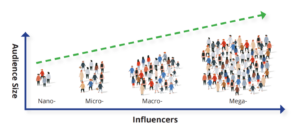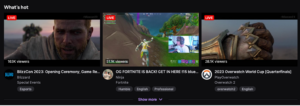For digital marketers, influencer marketing is quickly becoming one of the most exciting new methods for connecting with customers. A recent study found that influencer marketing has grown in value from around $1 billion in 2016 to over $20 billion in 2023, with no signs of slowing down in the near future.
For digital marketing educators, staying on top of this dynamic field can be a challenging task. Like the internet itself, the influencer landscape is constantly shifting and evolving. This perpetual motion can make it difficult to develop meaningful course content that can help students understand this important marketing field. Despite these challenges, influencer marketing is only going to become more important to businesses in the coming years, so digital marketing educators have a responsibility to teach their students the best practices and strategies for working with influencers on marketing campaigns.
With that in mind, this blog post will discuss some of the key aspects of influencer marketing: In particular, we’ll focus on working with micro-influencers, with a particular emphasis on the unique benefits that they can offer businesses. Most importantly, we’ll provide some practical activities that digital marketing educators can use to help students better understand micro-influencers and the value they can offer businesses.
What is a Micro-influencer?
Not all influencers are created equally. While there are a number of different ways to categorize influencers, they are most commonly broken down by their reach, or the number of followers they have across social media platforms. Mega-influencers have the largest reach, generally over one million, while macro-influencers usually have over 100 thousand. Micro-influencers generally have audiences in the tens of thousands, and nano-influencers tend to have around a thousand followers.

While each of these influencer types offer their own unique benefits to businesses, micro-influencers play a vital role in influencer marketing campaigns by offering a more intimate and relatable connection with their followers. They are known for their smaller but highly engaged following, typically in the tens of thousands of followers. Micro-influencers often focus on specific niches or areas of interest, catering to a dedicated community of enthusiasts.
What sets micro-influencers apart is the level of authenticity and trust they have built with their followers. Their audiences view them as knowledgeable and relatable figures, resulting in a stronger sense of credibility and influence. Micro-influencers frequently interact closely with their followers through comments, direct messages, live sessions, and other engagement channels, fostering a sense of community and personal connection.
For marketers, micro-influencers offer a number of key benefits:
- Micro-influencers are generally more cost-effective than macro- or mega-influencers, making them more accessible to businesses of all budgets. This also makes them a great entry point for businesses that have not engaged in influencer marketing before and are looking to experiment without a huge budgetary commitment.
- Micro-influencers tend to have a higher engagement rate, so while their content may not reach as wide of an audience, the audience that it does reach is more likely to engage with the content and convert.
- Micro-influencers can help businesses immediately establish a relationship of trust and authenticity with their potential customers. Micro-influencers tend to build much more intimate and personal relationships with their audience, and businesses can leverage this relationship through branded partnerships.

Working with Micro-influencers
To explore the value of working with micro-influencers, digital marketing educators can lead their students through the following activities:
Niche Mapping
Once of the most difficult aspects of working with micro-influencers is identifying the right influencer to partner with for a given business. Most commonly, this means finding an influencer whose audience is likely to overlap with the business’s target audience. For marketers, this means not only a strong understanding of a business’s target audience, but also the online niches—small communities built around narrow interests or hobbies—where this audience can be found.
To learn about different niches, students can be tasked with finding a local business and mapping out the niches that its target audience may be interested in. The key to this activity is getting students to be as precise and specific as possible. For instance, students may start by identifying “fitness enthusiasts” as the relevant niche for a local protein and supplements shop. If they drill down into this community, though, they may find even more specific niches, such as “vegan fitness enthusiasts,” or “professional powerlifting fans.” Each of these narrower niches will have their own unique community and micro-influencers for students to consider.
Platform Diversity
One key factor in the rise of micro-influencer marketing is the growing popularity of smaller social media platforms. While major platforms like Facebook and Instagram still attract huge audiences, there are a growing number of niche platforms where people with similar interests are connecting online. Film review network Letterboxd, Videogame streaming platform Twitch, or server-based microblogging platforms like Blue Sky and Mastodon are building smaller, more insular communities of users outside of mainstream social media channels.

To learn more about the diverse range of platforms for micro-influencers, students can be tasked with finding and briefly profiling a smaller social media platform and sharing their findings with the rest of the class. They should pay attention to factors such as the demographics of the platform, the kind of media that can be shared on the platform, notable or popular influencers on the platform, as well as any existing avenues for promotion or advertising that the platform has to offer.
Building Trust
One of the most important skills for an influencer of any size is to build trust with their audience. This is particularly important for influencers that engage in sponsored content or paid product endorsements: An influencer’s audience needs to trust them enough to consider checking out a product or business based on their recommendation, and endorsements that come across as inauthentic or otherwise untrustworthy are unlikely to generate any sales.
To best understand how influencers build trust, students can be tasked with finding an evaluating a piece of sponsored content (such as a YouTube video or Instagram post) and evaluating how the influencer maintains the trust of their audience. Students can be asked to identify things like disclosures of endorsement, or the kind of language that influencers use to discuss their relationship to their sponsor.
Through these activities, digital marketing educators can help their students better understand the world of influencer marketing and prepare them for a successful career in digital marketing.
To learn more about influencer marketing, check out Mujo’s Influencer Learning Fundamentals textbook.









 by
by